Mars - The Red Planet
504 - 518
Mars has long fascinated us. More than any other planet Mars changes its brightness in the sky and also at times undergoes dramatic episodes of retrograde motion. Through the telescope its growing and shrinking polar caps and greenish-hued areas have fired the human imagination. Does Mars support life? Has it supported life in the past? Little wonder that we have spent so much energy over the past 3 decades studying Mars with flyby and surface spacecraft missions.
Basic Facts
|
|||||||||||||||
| Figure 17.29 |
Historical Notes
Mars has long been a prominent player in astronomy - a role far in excess of its relatively small size.- The blood-red color prompted astrologers to associate the planet with Mars - the god of war. The appearance of Mars in various constellations ("houses") along the ecliptic was often interpreted as foreboding warfare. Brahe's observations and Kepler's analysis helped establish heliocentrism and overthrow the "circle dogma" of the Aristotelians.
- Giovanni Schiaparelli (1877) observed "canals" on Mars. Percival Lowell, a wealthy amateur, established the Lowell Observatory at Flagstaff, Arizona to study Mars among other topics.
- Largely on the impetus of Schiaparelli and Lowell authors such as Edgar Rice Burroughs and H. G. Wells wrote science fiction accounts of life and civilization on Mars.
- H.G. Wells' War of the Worlds was presented on radio in 1938 - narrated by Orson Welles. Aired as a "news bulletin" the radio program caused mass hysteria and anxiety throughout the U.S.
Planetary Characteristics
Early telescopic observations of Mars revealed an exciting world with polar caps and large green expanses that grew and shrank during the Martian year of 687 days. This helped fuel the speculation concerning life on Mars. Schiaparelli popularized the idea that the planet was criss-crossed by an elaborate canal system by publishing detailed maps of the Martian canal system.
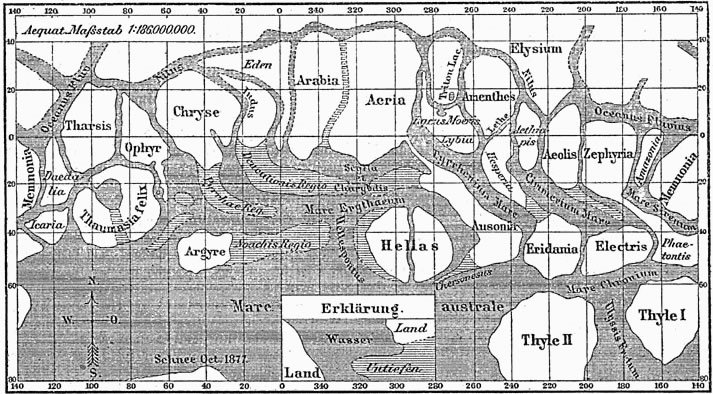 |
| Figure 17.30 1888 Map of Martian canals as drawn by Giovanni Schiaparelli (Image in public domain) |
Example 17.10 Estimate the size that "Martian canals" would have to be in order to be visible from the Earth.
Solution: If you consider Schiaparelli's telescopic observation then you must start with the basic idea that the Earth's atmosphere sets the limit of resolution that you can expect from a ground based telescope. As a good rule of thumb you can set 1" (1 second of arc) as the very best seeing Schiaparelli would have had. This means that the smallest detail he would be able to see though his telescope must subtend an angle of 1" or 1/3600th of a degree. At closest approach Mars is about 100 million kms from Earth. If you apply the small angle formula (see pg 34 - Reasoning With Numbers 3-1):
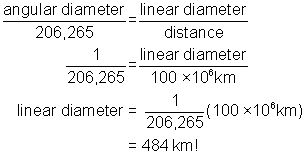
simple calculations show that such canals would have to be enormously wide to be visible from earth. Despite Schiaparelli's maps you must conclude that there are no Canals on Mars!
The high CO2 content of the Martian atmosphere favours the idea that the polar caps on Mars are primarily "dry ice" with some small content of water ice. Even though both poles have ice caps the northern polar cap loses its CO2 completely during its summer season and leaves behind the trace of water ice. This asymmetry is due to the ellipticity of the Martian orbit. The scarcity of water on Mars is an enigma. There is considerable reason to believe that Mars should have enough water to cover the planet to a depth of a few meters. This clearly is not the case and leads to a number of questions:
- was there more water on Mars at an earlier time? if there was water what happened to it?
- is there something fundamentally different about Mars?
The Formation of Atmospheres and Why is Mars So Different?
A clear picture is beginning to emerge - atmospheres arise from a complex set of phenomena that are affected by volcanic activity, plate activity and the presence or absence of liquid water. Mars may still be active volcanically and certainly was so in the recent past. A volcano releases trapped gases into the atmosphere. At this stage Earth and Mars would appear to be on equal footing. In their early histories both atmospheres probably started out in roughly the same way. But soon their paths diverge. On earth their is a continual interplay between:
|
|
||||||||||||||
Atmospheres and Planetary Mass
One factor that influences whether a planet will have an atmosphere or not is the mass of the planet, or more precisely the escape velocity form the planet. Recall that escape velocity is the minimum velocity an object can have to escape from the gravitational tug of a planet or star. Earth's escape velocity is 11.2 kms, the Moon's is 2.4 km/s and Mars is about 5 km/s.
| Figure 17.32 |
|
| Figure 17.31 |
|
| Figure 17.31 shows a computer simulation in which 100 Helium atoms at 400 K are in a small box. Figure 17.32 shows a graph of the velocities of the various atoms. As they collide some atoms get more energy (hence move faster) than others. On average the atoms share their energy in such a way that there will always be a few atoms that are moving at very high velocity. Some of these are moving faster than 5 km/s and if this was a sample from the Martian atmosphere these particles would be moving fast enough to escape into space. The Helium atoms will slowly "leak" into space because collisions will always produce a few very speedy atoms moving faster than the escape velocity. Figure 17.32 is a graph showing the planets and their escape velocities plotted along with the typical upper-end velocities in various gases and temperatures. | |
 |
|
| Figure 17.33 Graph of planetary escape velocity and typical velocity of the fastest particles in a gas for a given temperature. | |
Example 17.11 Would you expect Mars to be able to "hang on" to Hydrogen gas molecules (H2) for any appreciable length of time? How about the Earth - could it hold onto H2 molecules?
Solution: Inspect Figure 17.33. The escape velocity for Mars is well below the velocity for H2 molecules so it would be reasonable to expect that Hydrogen gas would "out-gas" rather quickly into interplanetary space. This would also be true for Earth but the process would likely take longer.
The Geology, Hydrology and History of Mars
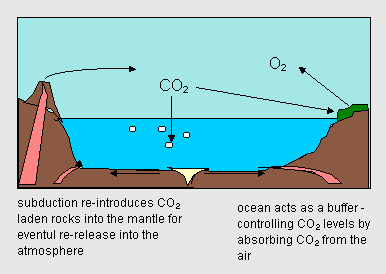 |
Oceans Play a BIG Role...CO2 is being filtered by the oceans. This prevents a steady build up of CO2 in the atmosphere (Venus' problem). At the same time CO2 combines other materials and life forms to become tied up in rock and sediment on the ocean floor. Eventually some of this carbonate rock is cycled by tectonic activity back into volcanoes where CO2 is again returned to the atmosphere. This helps maintain a supply of CO2 in the atmosphere which enables greenhouse warming to occur on earth. On Mars the situation is much different. |
Figure 17.34 The CO2 cycle. |
|
Primarily because of the more rapid cool-down time, Mars has a very thick crust and shows no evidence of plate activity. The return cycle of CO2 to the atmosphere is thwarted and the CO2 level steadily drops. Greenhouse warming does not occur on the planet, remaining water freezes out. Most of the Martian CO2 is "locked" in the form of carbonate rock that has no chance of being recycled. Mars lost most of its atmosphere very early in its history. It now has a very thin atmosphere which is similar to earth's atmosphere (in terms of pressure) at an altitude of 30 km! Magnetic Fields, Shields and the Solar WindA more subtle effect has to do with the interaction between the solar wind and the planetary atmosphere. Earth has probably always had a magnetic field and effective shield against the solar wind. Early in Martian history the core cooled, plate activity stopped and so did the Martian magnetic field. Without this protection from the solar wind, UV radiation could knock-apart water vapour molecules (H20). THe Hydrogen atoms would escape and the Oxygen would form oxides (rust-out!) on the surface. As well, C02in the atmosphere would be entrained with the solar wind and carried off. This, as well as a shut-down of vulcanism, all conspired to produce a thinning atmosphere. |
|
Conclusion: Mars suffers from a Reverse-Runaway Greenhouse Effect! |
|
|
|
 |
Thanks to detailed soil analysis sent back from the Viking (1970s), Pathfinder (1997) and Spirit and Opportunity (2004) missions to Mars we know a great deal about the soil of Mars. Unlike the earth, Martian soil appears to consist primarily of igneous materials with abnormal concentrations of silicon and iron. It is the iron - in the form of rust - that gives Mars its ruddy appearance. The fact that the surface of Mars is laden with heavier elements suggests that the planet is not as highly differentiated as earth. This may be due to the cooler environment in which Mars formed - not allowing enough time for element differentiation to occur before the planet solidified. The interaction of wind and soil on Mars gives rise to extensive wind erosion and the formation of large dunes. Perhaps one of the most significant discoveries of recent years concerns the appearance of flow channels revealing that water once flowed in great volumes across the Martian landscape. It has been suggested that a great deal of water is trapped in a permafrost layer. During the heating of Martian summers some of this permafrost melts rapidly and flash-flooding results. |
| Figure 17.35 Image of Martian landscape as captured by the Mars rover Spirit in 2006. Click on image for enlarged view. (Image courtesy NASA) | |
Volcanoes on Mars
The magnificent (probably extinct) volcano
Olympus Mons is the size of Arizona and more than 25 km high. An example of a Shield Volcano, it dwarfs any similar geologic form on earth. The enormous
size is probably due to two factors:
There are approximately 20 known volcanoes on Mars. Recent observations by the European Space Agency Mars Express suggest that Olympus Mons and several other volcanoes could have been active 1 or two million years ago and it is even possible that volcanic activity is still occurring on Mars. |
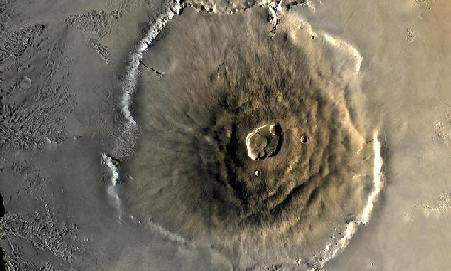 |
| Figure 17.36 Olympus Mons (satellite image courtesy NASA) |
In addition to shield volcanoes, Mars also has what are known as pyroclastic volcanoes. These literally explode on eruption and this may be linked to the presence of water or other volatiles trapped within the surface layers of the planet. Hot lava would cause rapid vapourization of these volatiles with explosive results. Other evidence that Mars either has or has had large quantities of water come from images of vast canyon systems. Figure 17.37a shows a segment of Valles Marineris. This vast canyon stretches more than 4000 km across the planet, 600 km at its widest and 6 km in depth. Hundreds of Grand Canyons (Figure 17.37b) could fit in this vast chasm! Valles Marineris likely formed as a result of crustal stresses - perhaps created by the overlying burden of heavy volcanic matter. Careful inspection of Valles Marineris, however, also reveals numerous channels and flood plains created by liquid water.
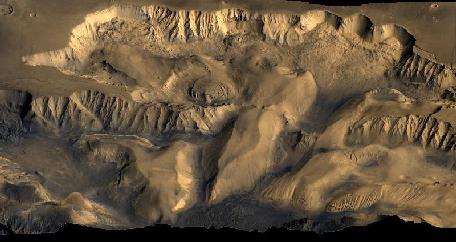 |
 |
| Figure 17.37a Valles Marineris is a huge canyon created by crustal stress and shaped by flowing water in the distant past (satellite image courtesy NASA) | Figure 17.37b The Grand Canyon in Arizona is literally dwarfed by Valles Marineris. (Image courtesy B. Martin) |
Images like Figure 17.33 reveal numerous dry river beds and flood plains - see if you can spot some. Mars is also heavily cratered - a trait shared by all of the Terrestrial planets (and the Moon). Very little is known in detail about the interior of Mars. It seems that volcanic activity has ceased but we see evidence of enormous volcano remnants on the planet. The absence of a magnetic field and the inferred absence of tectonic activity suggest that Mars does not have a hot, molten core.
Example 17.12 Why would mammoth shield volcanoes such as Olympus Mons suggest that Mars has a proportionally thicker crust than does the Earth?
Solution: Volcanic material is of considerably higher density than the crustal material. In order to support the weight of a volcano as large as Olympus Mons the crust would be required to be proportionally much thicker than what we observe on Earth.
Evidence for Catastrophic Climate Change
All of evidence collected to date suggests that Mars has undergone a profound change in its climate. It is very likely that early Mars had large quantities of liquid water. Land forms such as Valles Marineris as well as countless flow channels argue for this. The extensive set of volcanoes also suggests that the atmosphere may have at one time been more substantial than it is today. But the evidence also suggest that Mars has cooled off and no longer has an active core and certainly lacks the plate activity so important to Earth. Furthermore - without a mechanism to replenish its atmosphere the low mass of Mars makes it difficult for the "Red Planet" to hold onto its atmosphere. Finally, with only a weak magnetic field to shield Mars against the Solar Wind the atmosphere is also being constantly stripped away.
The Cratered Surface of Mars
The surface of Mars is littered with numerous impact craters. Unlike the Moon, however, most craters are relatively young. Very old craters, just as on Earth, have been subjected to erosion processes that make them impossible or very difficult to identify. Figure 17.34 shows an example of a Martian impact crater.
| All evidence supports the common theme that Mars also experienced an epoch of heavy bombardment and that asteroidal and cometary impact continues to occur (although at a vastly reduced rate). | 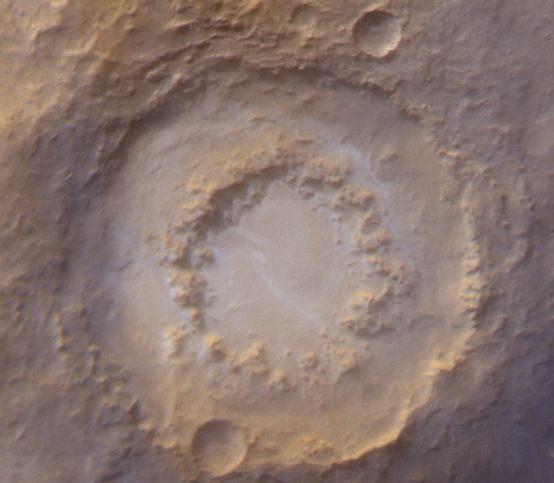 |
| Figure 17.38 An impact crater on the surface of Mars. |
Searching for Life
Both Viking 1 and 2 carried on board experiments to test soil samples for life forms. They found none but the results were not conclusive. We now see that the Martian environment is a very harsh one. If life is present it would be at best in a microbial form and perhaps difficult to detect.
Beginning in the late 1990's and early 2004 a series of very successful Mars rovers explored the Martian surface and finally found conclusive evidence that Mars was once much richer in liquid water than today. Whether or not microbial life has ever existed on Mars is, however, still very much an open question.
The Martian Satellites: Phobos and Deimos
Mars has two small and very peculiar satellites. These moons are much more similar to asteroids than, for example, Earth's moon. It is possible that they were "captured" by the planet at an earlier epoch.
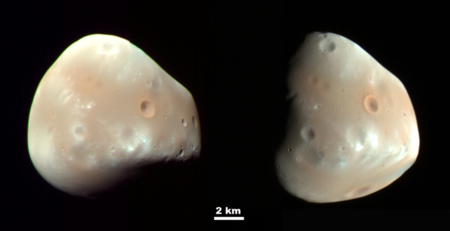 |
Deimos is the smallest known moon in the solar system and orbits only 6000 km above Mars in a mere 7 hours! It moves so fast that you would see it rise in the west and set in the east - several times per day! The orbit of Deimos is decaying and it is expected that it will collide with Mars within the next 30 million years. Deimos has a density of 1.8 g/cc and is heavily cratered and scoured. |
| Figure 17.39 Deimos (image courtesy NASA) | |
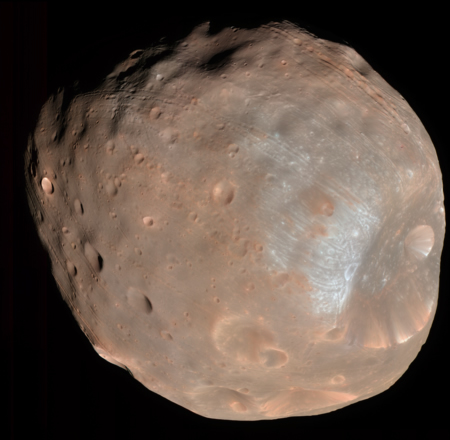 |
Phobos orbits Mars with a period of 1.26 Earth days. Like Deimos, it is small and low density (1.6 g/cc). It is quite possible that both Deimos and Phobos contain large quantities of water-ice. If so, this could be very important for the eventual establishment of space stations orbiting Mars. |
| Figure 17.40 Phobos (image courtesy NASA) |
Practice
- What is a shield volcano? What does the fact that all of Mars' volcanoes are shield volcanoes tell you about plate activity on Mars?
- Provide at least 3 different arguments that suggest that at an earlier time the climate on Mars was much different than it is today.
- Why is Mars red?
- In what way can we claim that Mars has experienced a "reverse Runaway Greenhouse" effect?
- Why is it reasonable to suspect that Phobos and Deimos may have formed in different part of the early solar system?
- Inspect the following Mars Orbiter Mission image taken June 1999. Describe the features that you can see and explain their significance. Can you see any evidence for the existence of liquid water on the planet? Click on the image to enlarge it.

Click on image to enlarge. (Image courtesy NASA)

Chp 22-2,3
![]()
![]()